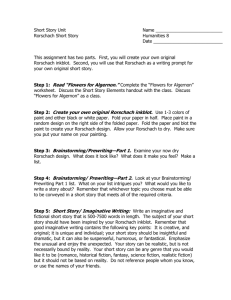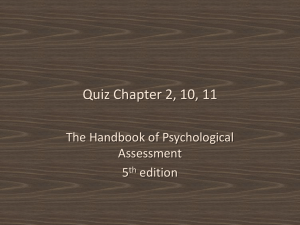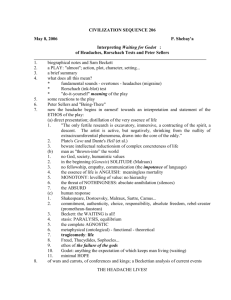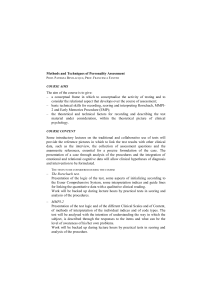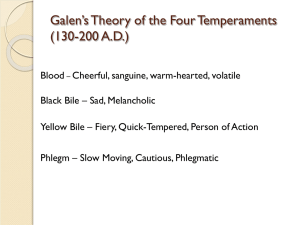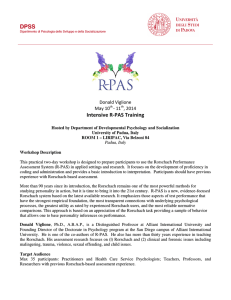References
advertisement
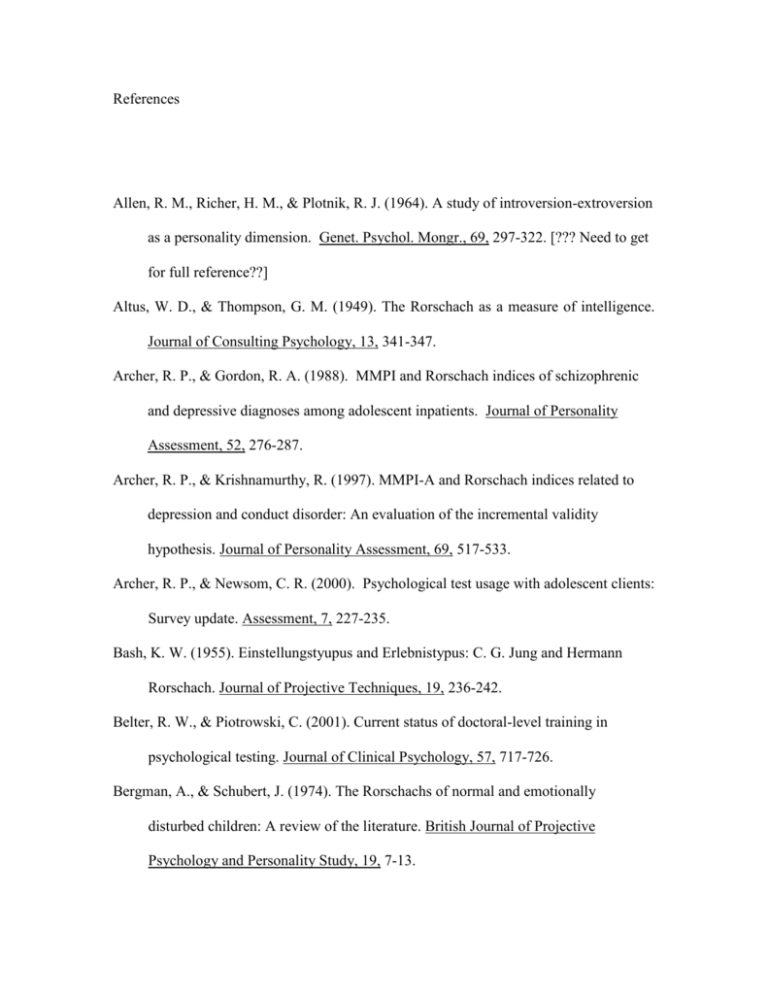
References Allen, R. M., Richer, H. M., & Plotnik, R. J. (1964). A study of introversion-extroversion as a personality dimension. Genet. Psychol. Mongr., 69, 297-322. [??? Need to get for full reference??] Altus, W. D., & Thompson, G. M. (1949). The Rorschach as a measure of intelligence. Journal of Consulting Psychology, 13, 341-347. Archer, R. P., & Gordon, R. A. (1988). MMPI and Rorschach indices of schizophrenic and depressive diagnoses among adolescent inpatients. Journal of Personality Assessment, 52, 276-287. Archer, R. P., & Krishnamurthy, R. (1997). MMPI-A and Rorschach indices related to depression and conduct disorder: An evaluation of the incremental validity hypothesis. Journal of Personality Assessment, 69, 517-533. Archer, R. P., & Newsom, C. R. (2000). Psychological test usage with adolescent clients: Survey update. Assessment, 7, 227-235. Bash, K. W. (1955). Einstellungstyupus and Erlebnistypus: C. G. Jung and Hermann Rorschach. Journal of Projective Techniques, 19, 236-242. Belter, R. W., & Piotrowski, C. (2001). Current status of doctoral-level training in psychological testing. Journal of Clinical Psychology, 57, 717-726. Bergman, A., & Schubert, J. (1974). The Rorschachs of normal and emotionally disturbed children: A review of the literature. British Journal of Projective Psychology and Personality Study, 19, 7-13. Board of Professional Affairs (1998). Awards for distinguished professional contributions: John Exner. American Psychologist, 53, 391-92. Bochner, R., & Halpern, F. (1942). The clinical application of the Rorschach test. New York: Grune & Stratton. Bochner, R., & Halpern, F. (1945). The clinical application of the Rorschach test (2nd ed.). New York: Grune & Stratton. Bonifacio, P. P., & Schaefer, C. E. (1969). Creativity and the projection of movement responses. Journal of Projective Techniques and Personality Assessment, 33, 380384. Borum, R., & Grisso, T. (1995). Psychological test use in criminal forensic evaluations. Professional Psychology: Research and Practice, 26, 465-473. Boswell, D. L. (1989). Rorschach EB as a predictor of imaging style. Perceptual & Motor Skills, 68, 1001-1002. Caine, S. L., Frueh, B. C., & Kinder, B. N. (1995). Rorschach susceptibility to malingered depressive disorders in adult females. In J. N. Butcher & C. D. Spielberger (Eds.). Advances in personality assessment. Volume 10 (pp. 165-174). Hillsdale, NJ: Erlbaum. Cerbus, G., & Nichols, R. C. (1963). Personality variables and response to color. Psychological Bulletin, 60, 566-575. Culross, R. R., & Nelson, S. (1997). Training in personality assessment in specialist-level school psychology programs. Psychological Reports, 81, 119-124. Dana, R. H. (1968). Six constructs to define Rorschach M. Journal of Projective Techniques and Personality Assessment, 32, 138-145. Dana, R. H., & Cocking, R. R. (1968). Cue parameters, cue probabilities, and clinical judgment. Journal of Clinical Psychology, 24, 475-480. Exner, J. E. (1997). The future of Rorschach in personality assessment. Journal of Personality Assessment, 68, 37-46. Fonda, C. P. (1960). The white-space response. In M. A. Rickers-Ovsiankina (Ed.), Rorschach psychology ( pp. 80-105). [This is an excellent review. Very thoughtful and thorough. Says that Space responses appear to be an indicator of ego strength -that a person is bright, productive, flexible, ingenious, and self-sufficient. Exner (1993) cites this review as if Fonda supports his interpretation of Space responses as an indicator of anger!!! I am going to point out the irony in our book] Frank, G. (1976). On the validity of hypotheses derived from the Rorschach: I. The relationship between color and affect. Perceptual and Motor Skills, 43, 411-427. [Title explains the topic of this review. Takes position that Rorschach’s hypotheses re: SumC have not been confirmed] Frank, G. (1979). On the validity of hypotheses derived from the Rorschach: VI. M and the intrapsychic life of individuals. Perceptual and Motor Skills, 48, 1267-1277. Frank, G. (1993a). On the meaning of movement responses on the Rorschach. Psychological Reports, 73, 1219-1225. Frank, G. (1993b). On the validity of hypotheses derived from the Rorschach: The relationship between color and affect; Update 1992. Psychological Reports, 73, 1214. [Follow-up on Frank, 1976] Frank, G. (1993c). On the validity of Rorschach’s hypotheses: The relationship of space responses to oppositionalism. Psychological Reports, 72, 1111-1114. [Not the greatest review in the world, but gives citations that come after Fonda’s review.] Frank, L. (1939a). Comments on the proposed standardization of the Rorschach method. Rorschach Research Exchange, 3, 101-105. Frank, L. (1939b). Projective methods for the study of personality. The Journal of Psychology, 8, 389-413. Frank, L. (1948). Projective methods. Springfield, Illinois: Charles C. Thomas. Goddard, H. H. (1908). The Binet and Simon tests of intellectual capacity. Training School Bulletin, 5 (10), 3-9. Goddard, H. H. (1910). A measuring scale for intelligence. Training School Bulletin, 6, 146-155. Goodenough, F. L. (1949). Mental Testing: Its history, principles, and applications. New York: Rinehart & Company. Hagen, M. A., & Castagna, N. (2001). The real numbers: Psychological testing in custody evaluations. Professional Psychology: Research and Practice, 32, 269-271. Haller, N., & Exner, J. E. (1985). The reliability of Rorschach variables for inpatients presenting symptoms of depression and/or helplessness. Journal of Personality Assessment, 49, 516-521. Hertz, M. R. (1986). Rorschachbound: A 50-year memoir. Journal of Personality Assessment, 50, 396-416. Hilgard, E. R. (1987). Psychology in America: A historical survey. San Diego, California: Harcourt Brace Jovanovich. Holtzman, W. H. (1950a). Validation studies of the Rorschach test: Impulsiveness in the normal superior adult. Journal of Clinical Psychology, 6, 348-351. Holtzman, W. H. (1950b). Validation studies of the Rorschach test: Shyness and gregariousness in the normal superior adult. Journal of Clinical Psychology, 6, 343347. Holtzman, W. H. (1952). Adjustment and leadership: A study of the Rorschach test. Journal of Social Psychology, 36, 179-189. Holtzman, W. H., & Sells, S. B. (1954). Prediction of flying success by clinical analysis of test protocols. Journal of Abnormal and Social Psychology, 49, 485-490. Kessler, J. W. (1994). Marguerite R. Hertz (1899-1992). American Psychologist, 49, 1084. Klopfer, B. (1940). Personality aspects revealed by the Rorschach method. Rorschach Research Exchange, 4, 26-29. Klopfer, B., & Kelley, D. M. (1946). The Rorschach technique. Yonkers-on-Hudson, New York: World Book. Kunce, J. T., & Tamkin, A. S. (1981). Rorschach movement and color responses and MMPI social extraversion and thinking introversion personality types. Journal of Personality Assessment, 45, 5-10. Lipovsky, J. A., Finch, A. J., & Belter, R. W. (1989). Assessment of depression in adolescents: Objective and projective measures. Journal of Personality Assessment, 53, 449-458. Lotsof, E. J. (1953). Intelligence, verbal fluency, and the Rorschach test. Journal of Consulting Psychology, 17, 1953. Lotsof, E. J., Comrey, A., Bogartz, W., & Arnsfield, P. (1958). A factor analysis of the WISC and Rorschach. Journal of Projective Techniques, 22, 297-301. Masling, J.xxxxx Add citation. Meltzoff, J., Singer, J. L., & Korchin, S. J. (1953). Motor inhibition and Rorschach movement responses: A test of the sensory-tonic theory. Journal of Personality, 21, 400-410. Morganthaler, W. (1954). Der kampf um das erscheinen der Psychodiagnostik. Zeitschrift eur diagnostische psychologie und perseonlichkeitsforschung, 2, 255-271. Murray, D.C. (1957). White space on the Rorschach: Interpretation and validity. Journal of Projective Techniques, 21, 47-53. [A mediocre review, but still worth consulting] Palmer, J. O. (1956). Attitudinal correlates of Rorschach’s Experience Balance. Journal of Projective Techniques, 20, 207-211. Phillips, L., & Smith, J. G. (1953). Rorschach Interpretation: Advance Technique. New York: Grune & Stratton. Pinkerman, J. E., Haynes, J. P., & Keiser, T. (1993). Characteristics of psychological practice in juvenile court clinics. American Journal of Forensic Psychology, 11, 312. Piotrowski, C., Belter, R. W., & Keller, J. W. (1998). The impact of “Managed Care” on the practice of psychological testing: Preliminary findings. Journal of Personality Assessment, 70, 441-447. Piotrowski, Z. A. (1957). Perceptanalysis. New York: Macmillan. Piotrowski, Z. A. (1980). CPR: The psychological x-ray in mental disorders. In J. B. Sidowski, J. H. Johnson, & T. A. Williams (Eds.), Technology in mental health care delivery systems (pp. 85-108). Norwood, New Jersey: Ablex Publishing. Riesman, J. M. (1976). A history of clinical psychology. New York: Irvington. Routh, D. K. (1994). Clinical psychology since 1917: Science, practice, and organization. New York: Plenum. Shapiro, D. (1960). A perceptual understanding of color response. In M. A. RickersOvsiankina (Ed.), Rorschach psychology ( pp. 154-201). New York: John Wiley & Sons. Singer, J. L. (1960). Some experience type: Some behavioral correlates and theoretical implications. In M. A. Rickers-Ovsiankina (Ed.), Rorschach psychology ( pp. 223259). New York: John Wiley & Sons. [Although the title suggests that the review is about EB, in fact the review focuses on M almost exclusively, and makes a good case that M seems to be related to (a) imaginativeness or fantasy capacity (though not necessarily artistic achievement or creativity, (b) motor activity, and (c) thoughtfulness and self-inhibition on cognitive tasks. Why weren’t these hypotheses followed up in subsequent research? Although Singer never says so outright, he seems to suggest that Sum C has not been validated nearly as well as M. It appears that M, not Sum C, is the “active ingredient” in EB, and that the more M the better i.e. high M does not seem associated with lack of spontaneity or compulsiveness.] Singer, J. L., & Brown, S.-L. (1977). The experience type: Some behavioral correlates and theoretical implications. In M. A. Rickers-Ovsiankina (Ed.), Rorschach Psychology (2nd ed.) (pp. 325-372). Huntington, New York: Robert E. Krieger. Singer, J. L., & Herman, J. (1954). Motor and fantasy correlates of Rorschach human movement responses. Journal of Consulting Psychology, 18,325-331. Singer, J. L., & Spohn, H. (1954). Some behavioral correlates of Rorschach's experiencetype. Journal of Consulting Psychology, 18, 1-9. Singer, J. L., Wilensky, H., & McCraven, V. (1956). Delaying capacity, fantasy, and planning ability: A factorial study of some basic ego functions. Journal of Consulting Psychology, 20, 375-383. [May need to delete this reference. I was going to cite it as evidence of correlation of motor activity w/ M -- but it was a factor analysis and probaby isn't a great citation for this issue] Tegtmeyer, P. F., & Gordon, M. (1983). Interpretation of white space responses in children’s Rorschach protocols. Perceptual and Motor Skills, 57, 611-616. [A single empirical study with children. But the results confirm Fonda’s interpretation of Space responses! Also, it gives some relevant citations from *after* Fonda’s review.] Thornton, G. R., & Guilford, J. P. (1936). The reliability and meaning of Erlebnistypus scores in the Rorschach test. Journal of Abnormal and Social Psychology, 31, 324330. Watkins, C. E., Campbell, V. L., Nieberding, R., & Hallmark, R. (1995). Contemporary practice of psychological assessment by clinical psychologists. Professional Psychology: Research and Practice, 26, 54-60. Williams, H. L., & Lawrence, J. F. (1953). Further investigation of Rorschach determinants subjected to factor analysis. Journal of Consulting Psychology, 17, 261-264. Wysocki, B. A. (1956). Differentiation between introvert-extravert types by Rorschach method as compared with other methods. Journal of Psychology, 43, 41-46. Zenderland, L. (1998). Measuring minds: Henry Herbert Goddard and the origins of American intelligence testing. Cambridge, England: Cambridge University Press. Zubin, J., Eron, L. D., & Schumer, F. (1965). An experimental approach to projective techniques. New York: John Wiley & Sons. [Review of Space responses on p. 233, of Color Shock on pp. 229-232]
